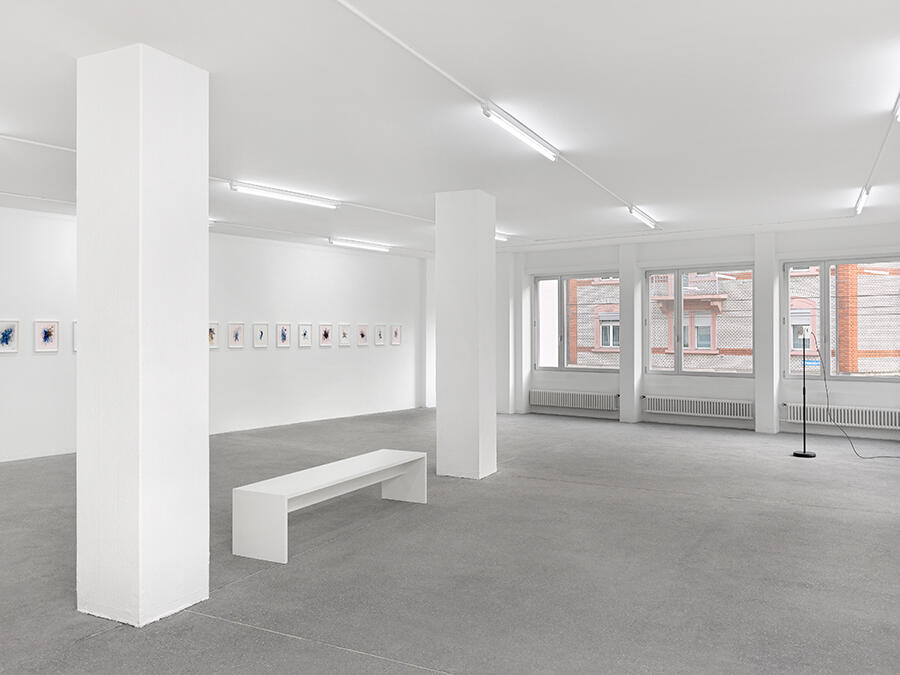Tosh Basco Finds Catharsis through Mark-Making
At Karma International, Zurich, the artist’s new series of prints allude to the trauma of grief
At Karma International, Zurich, the artist’s new series of prints allude to the trauma of grief

Created while processing a personal loss against a backdrop of global turmoil, Tosh Basco’s ‘Grief Series’, currently on view at Zurich’s Karma International, is an attempt to find catharsis through mark-making. In a new direction for the artist, whose practice is typically more ephemeral and collaborative, the exhibition is almost entirely made up of modestly sized works on paper. It’s a curious choice for Basco, who is best-known for her gender-bending, hypnotic performances, which she has staged under the moniker ‘boychild’ since 2012 – initially in the drag bars of San Francisco and, later, in art institutions such as Berlin’s Gropius Bau, the Whitney Museum of American Art in New York and the Stedelijk Museum, Amsterdam.

Though the exhibition consists mostly of prints, a looped sound piece echoes through the gallery featuring textured audio of the artist exhaling, sighing, mumbling and groaning while working (Remnants, all works 2021). Loquacious yet hushed, the audio is accompanied by 50 assorted works on paper that politely line the walls or, in one case, rest gently atop a pedestal (Floored). Adding another layer to the experience of viewing these pieces, Remnants creates a ghost performance by Basco that acts as a perfect metaphor for grief itself: embodied trauma, unconsciously bared.
The trauma of grief – alluded to in both the exhibition’s title and its literature, which refers to ‘a very personal incidence of loss’ in Basco’s life – can also be sensed in the work's muted palette. Each print comprises built-up strokes of subdued greys, fleshy pinks and deep blues, akin to the discoloration of decomposing bodies. Many are given single-word titles suggestive of emotional intensity – Relinquish, Shatter, Scratch, Flight, Embrace, Rest, Toil – but, ultimately, the abundance of these works and the apparent speed of their mark-making renders it difficult to distinguish between them, leaving their Dadaesque titles to do all the heavy symbolic labour.

Though the body is never directly portrayed, its presence is evoked through marks made by dragged fingers, smeared hands and other errant limbs in a nod towards action and movement set against the negative space in each work. In this way, Basco’s drawings are reminiscent of choreographer Trisha Brown’s abstract notations, which displayed her prowess for articulating improvisational dance through multilayered, symbolic drawings. But while Brown’s untitled works revel in their abstraction, Basco’s reliance on sound and language to suggest the body in motion hints at a lack of confidence in this new medium to fully express the complexity of grief.

Nodding towards the figural in a liminal space, ‘Grief Series’ is a step towards a practice that is not singularly based in performance but stops short of leaving it behind completely. Speaking to artist Sophia Al Maria for Art Agenda in April 2021, Basco noted this ambivalence: ‘Well, I miss performing, I miss being with people […] I continue to stand by live performance as a medium to communicate through even if, for now, it is through its absence.’ Moving through the exhibition, I felt this absence in my own longing to experience artwork that isn’t defined by a perma-pandemic society. At the same time, this sense of loss is also exactly what the artist captures as she introduces viewers to new ways of seeing her work and, perhaps, to a broader acknowledgement of a new normal without performance – or the performer – as we know it.
Tosh Basco's ‘Grief Series’ is on view at Karma International, Zurich, Switzerland, until 29 January.
Main image: Tosh Basco, ‘Grief Series’, 2021, exhibition view, Karma International, Zurich. Courtesy: the artist and Karma International, Zurich; photograph: © Annik Wetter
























